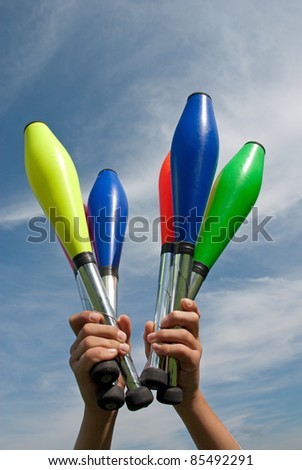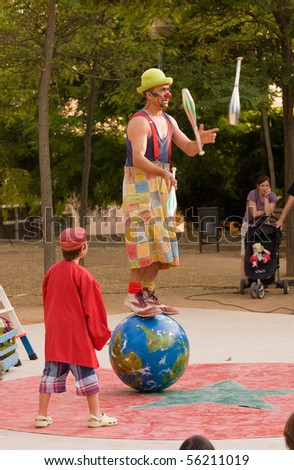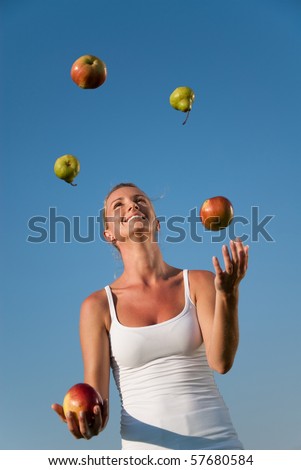Ancient to 20th century

This ancient wall painting (c. 1994-1781 B.C) appears to depict jugglers. It was found in the 15th tomb of the Karyssa I area, Egypt. According to Dr. Bianchi, associate curator of the Brooklyn Museum “In tomb 15, the prince is looking on to things he enjoyed in life that he wishes to take to the next world. The fact that jugglers are represented in a tomb suggests religious significance.” … “round things were used to represent large solar objects, birth, and death.”
The earliest record of juggling, a panel from the 15th Beni Hasan tomb of an unknown prince, shows female dancers and acrobats throwing balls. Juggling has been recorded in many early cultures including Egyptian, Chinese, Indian, Greek, Roman, Norse, Aztec (Mexico) and Polynesian civilizations.,[4][5]
In Europe, juggling was an acceptable diversion until the decline of the Roman Empire, after which it fell into disgrace. Throughout the Middle Ages most histories were written by religious clerics who frowned upon the type of performers who juggled, called ‘gleemen’, accusing them of base morals or even practising witchcraft. Jugglers in this era would only perform in marketplaces, streets, fairs, or drinking houses. They would perform short, humorous and bawdy acts and pass a hat or bag among the audience for tips. Some kings’ and noblemen’s bards, fools, or jesters would have been able to juggle or perform acrobatics, though their main skills would have been oral (poetry, music, comedy and storytelling).
In 1768 Philip Astley opened the first modern circus. A few years later he employed jugglers to perform acts along with the horse and clown acts. Since then, jugglers have been associated with circuses.
In the 19th century variety and music hall theatres became more popular, and jugglers were in demand to fill time between music acts, performing in front of the curtain while sets were changed. Performers started specializing in juggling, separating it from other kinds of performance such as sword swallowing and magic. The Gentleman Juggler style was established by German jugglers such as Salerno and Kara. Rubber processing developed, and jugglers started using rubber balls. Previously juggling balls were made from balls of twine, stuffed leather bags, wooden spheres, or various metals. Solid or inflatable rubber balls meant that bounce juggling was possible. Inflated rubber balls made ball spinning easier and more readily accessible. Soon in North America, vaudeville theatres employed jugglers, often hiring European performers.
20th century

In the early to mid-20th century, variety and vaudeville shows decreased in popularity due to competition from motion picture theatres, radio and television, and juggling suffered as a result. Music and comedy transferred very easily to radio but juggling could not. In the early years of TV, when variety-style programming was popular, jugglers were often featured. But developing a new act for each new show, week after week, was more difficult for jugglers than other types of entertainers; comedians and musicians can pay others to write their material but jugglers cannot get other people to learn new skills on their behalf.
In the early 1950s, more people began juggling as a hobby.[citation needed] The International Jugglers’ Association began as a club for performing jugglers, but soon non-performers joined and started attending the annual conventions. The IJA continues to hold an annual convention each summer.
World Juggling Day was created as an annual day of recognition for the hobby, with the intent to teach people how to juggle, to promote juggling or for jugglers to get together and celebrate. Traditionally it is held on a Saturday in mid June.
Most cities and large towns now have juggling clubs. These are often based within, or connected to, universities and colleges. There are also community circus groups that teach young people and put on shows. The Internet Juggling Database maintains a searchable database of most juggling clubs.
Since the 1980s a juggling culture has developed. The scene revolves around local clubs and organizations, special events, shows, magazines, web sites, internet forums and, possibly most importantly, juggling conventions. In recent years there has also been a growing focus on juggling competitions. Juggling today has evolved and branched out to the point where it is synonymous with all prop manipulation. The wide variety of the juggling scene can be seen at any juggling convention.
Juggling conventions or festivals form the backbone of the juggling scene. The focus of most juggling conventions is the main space used for open juggling. There will also be more formal workshops in which expert jugglers will work with small groups on specific skills and techniques. Most juggling conventions also include a main show (open to the general public), competitions, and juggling games.



 Check this OUT!!!
Check this OUT!!!